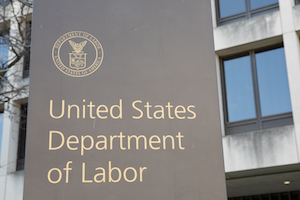The Department of Labor (DOL) has taken the first step in exploring ways to improve the effectiveness of retirement plan disclosures under ERISA, consistent with Section 319 of the SECURE 2.0 Act of 2022. 
More specifically, the DOL’s Employee Benefits Security Administration (EBSA) on Oct. 18 notified the White House Office of Management and Budget (OMB) that it intends to begin consulting with stakeholders—including participant representatives, employers sponsoring ERISA retirement plans, and retirement plan service and investment providers—to explore alternatives for improving the understandability and effectiveness of such plan disclosures.
According to the regulatory agenda item, the review will explore “whether, and how, the content, design, and delivery of such disclosures may be reimagined, improved, consolidated, standardized, and simplified to enhance participants’ disclosure experiences, promote greater participant engagement, and improve outcomes.”
The guidance project submitted for review is listed as in the pre-rule stage, whereby government agencies undertake this type of action to solicit public comment on whether and/or how best to initiate a rulemaking; such actions typically occur prior to the proposed rule stage.
Enacted in December 2022, the SECURE 2.0 Act contains multiple reporting and disclosure provisions, including new disclosure requirements for defined benefit and defined contribution retirement plans covered by ERISA. The new law also includes provisions relating more generally to effectiveness, simplification, and consolidation of applicable disclosures.
Section 319 of SECURE 2.0 specifically directs the Treasury Department, DOL and Pension Benefit Guaranty Corporation (PBGC) to review reporting and disclosure requirements for pension plans as soon as practicable after enactment. In addition, it directs the agencies to make recommendations to Congress to consolidate, simplify, standardize and improve such requirements no later than three years after enactment.
Like the 408(b)(2) requirements imposed a decade ago to assist plan fiduciaries in assessing and comparing the reasonableness of fees, the provisions in SECURE 2.0 are part of a larger effort to simplify what critics say are complex, inconsistent, and jargon-heavy reporting and disclosure forms.
This past June, the Senate Committee on Health, Education, Labor, and Pensions (HELP) sent a letter to the DOL urging the agency to prioritize six provisions related to the committee’s jurisdiction. One of those, for example, was section 341 in SECURE 2.0, directing the Treasury Department and DOL to “amend regulations to permit a plan to consolidate certain required notices into a single notice.”
In August, the DOL issued a Request for Information (RFI) to gather public input in relation to simplifying and consolidating retirement plan reporting and disclosure forms, as directed by SECURE 2.0.
In addition to the items above, other SECURE 2.0 disclosure reforms include the following:
Eliminate plan requirements for unenrolled participants: Allows plans to provide much more limited information to employees who are not contributing to a plan and have no balance in the plan; must have provided a summary plan description (SPD), any required eligibility notices, and an annual notice.
Fee disclosure improvements: Review and report on improving fee disclosures in three years.
Paper statement mandate: Requires at least one annual benefit statement to be delivered on paper unless the participant opts out of the paper requirement. The paper disclosure requirement is once every three years for defined benefit plans. No paper would be required for wired-at-work or those who opt out of paper.
Report on Rollover Notices: Requires GAO to issue a report to four committees on the effectiveness of section 402(f) notices with recommendations.
The DOL notes that the review undertaken by this regulatory project will take into account these new provisions individually and in the aggregate.
- Log in to post comments
